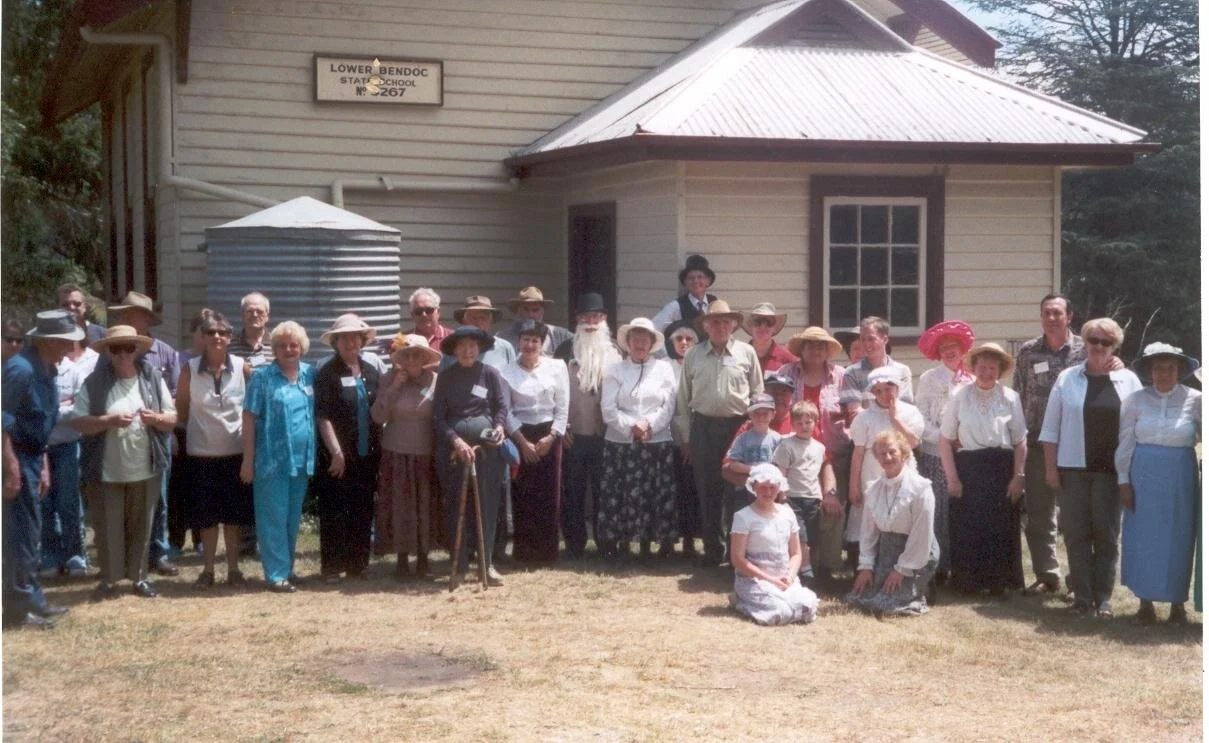In 2002, the Saints History Association of Victoria organised a weekend meeting at a little country schoolhouse at Lower Bendoc, East Gippsland, Victoria, those attending were accommodated in the town of Delegate, 21.2 km away, in NSW.
The reason for the meeting at Lower Bendoc was because it was where a branch of the church was organised by Harold Velt in 1915 and continued to function until 1937 when it closed due to declining membership. Lower Bendoc is just over the NSW/Victoria border and members homes were dotted on either side. One of the papers presented over the weekend was "A Border Between - the Lower Bendoc Branch 1915-1937" which was compiled by church Historian, Margaret Morris.
The paper illustrates how the Spanish Influenza Pandemic of 1919 affected the church, including the closure of the border over 100 years ago when a fence was erected to separate the two states and an excerpt is presented below.
A Border Between - The Lower Bendoc Branch 1915-1937 , By Margaret Morris
(Excerpt from pp.14-16)
“Annually, over the years as winter approaches, the threat of yet another influenza outbreak is often heard. In the winter of 1918, before World War One was over, there was a sudden increase in the incidence of the ‘flu in New South Wales. This turned out to be the prelude to the 1919 influenza pandemic which claimed the lives of 6,387 people in New South Wales alone, just over half of all the deaths recorded in Australia. It was thought to have been brought to Australia by soldiers returning home from the War. By early 1919 the state government prohibited the public use of libraries, reading rooms, theatres, music halls, auction rooms, billiard rooms and indoor or outdoor church services within the County of Cumberland. The wearing of masks was compulsory. Shops were not permitted to hold bargain or clearance sales which attracted crowds and only limited numbers of people were allowed to gather in shops, hotels, tea-rooms and restaurants. Quarantine regulations were tightened and travel on long-distance trains was restricted. As they returned from the war, troops were quarantined at North Head and the Sydney Cricket Ground. In the winter of 1919 the epidemic peaked in New South Wales. By February 1920 it had abated. 31
31 “An End to Influenza?”, The 1918-1919 flu pandemic in Australia,, Australian Academy of Science, 1996, p. 1. 32 Grant, Anne, Influenza Pandemic 1919 – Extracts from the “Portland Guardian‟ and “Portland Observer‟, pp. 1-3.
The influenza epidemic first appeared in Melbourne in January 1919. On 21 January that year picture shows, theatres, churches, public meetings and races were closed. Trains services within Victoria were running as usual but interstate trains were not allowed to travel over the border. Business people thought commercial travellers were a health risk. They believed the travellers were likely to carry the influenza germ to sickness free areas. By 11 April there were 12,972 reported cases in the state of Victoria resulting in 714 deaths in the metropolitan area and 89 in country areas. No Anzac Day memorial services were held in 1919. 32
Missionary Herman Peisker reported in the March 1919 Gospel Standard from Melbourne that Victoria was then quarantined due to the outbreak of the ‘flu epidemic and that he was stranded there indefinitely. Undaunted by the possibility of succumbing to the disease himself or the fact that restrictions had been placed on areas which were infected, in January he travelled to Bairnsdale to assist Harold Velt and Albert Loving. He reported from there that the epidemic had upset all their plans. They were restricted in holding services, teaching and visiting, etc. 33
The Lower Bendoc Branch of the church was affected by the pandemic in unique way because it was divided by a state border. With some members living in New South Wales and others living in Victoria, those on either side of the border were forbidden to cross it for any reason. Correspondent, Edith Lawless, reported that the best the branch could do was for those on the Victorian side to meet together for Sunday School and church services, while those on the New South Wales side would do likewise. Edith relates how the Victorians and New South Wales members missed the fellowship of one another throughout the restrictions. However, it was some consolation that members were permitted to go to the border and talk to each other across the fence. They were thankful for that privilege, but were disappointed when a visit from missionary John Corbett had to be postponed. As restrictions were lifted they were able to go 10 miles (16 kilometres) each side of the border.34 Before the crisis was over, however, a Victoria District reunion was held in Melbourne at Easter 1919. Following the reunion Harold Velt and some other members of the church suddenly came down with the ‘flu. Velt recalls that, after administration, some of them had remarkable healings. Unfortunately, he haemorrhaged for several days and was not expected to live. His recovery was due to the kindness of Brother and Sister J.H.N. Jones who took care of him in their home for two weeks until he was well enough to return to Bairnsdale.“ 35
Group gathering, organised by the Saints History Association of Victoria, at a little country schoolhouse at Lower Bendoc in 2002
Photo courtesy of Margaret Morris
The Schoolhouse (Lower Bendoc)
Photo courtesy of Margaret Morris


